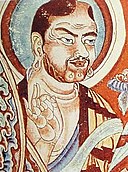Файл:Central Asian Buddhist Monks.jpeg
Central_Asian_Buddhist_Monks.jpeg (470 × 591 пікселів, розмір файлу: 173 КБ, MIME-тип: image/jpeg)
Історія файлу
Клацніть на дату/час, щоб переглянути, як тоді виглядав файл.
| Дата/час | Мініатюра | Розмір об'єкта | Користувач | Коментар | |
|---|---|---|---|---|---|
| поточний | 12:25, 27 березня 2005 |  | 470 × 591 (173 КБ) | Beta m common | 9th century fresco from Bezeklilk, Tarim Basin. {{PD-art}} |
Використання файлу
Такі сторінки використовують цей файл:
Глобальне використання файлу
Цей файл використовують такі інші вікі:
- Використання в ar.wikipedia.org
- Використання в ast.wikipedia.org
- Використання в az.wikipedia.org
- Використання в ba.wikipedia.org
- Використання в bg.wikipedia.org
- Використання в bjn.wikipedia.org
- Використання в bn.wikipedia.org
- Використання в bs.wikipedia.org
- Використання в bxr.wikipedia.org
- Використання в ca.wikipedia.org
- Використання в cs.wikipedia.org
- Використання в cv.wikipedia.org
- Використання в da.wikipedia.org
- Використання в de.wikipedia.org
- Використання в de.wikivoyage.org
- Використання в el.wikipedia.org
- Використання в en.wikipedia.org
Переглянути сторінку глобального використання цього файлу.

